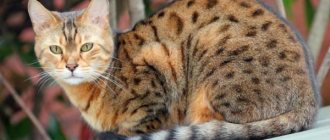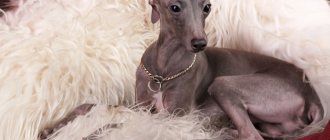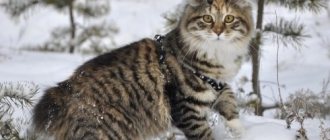History of the breed
There is a legend that the ancestors of these animals arrived in Japan from China. Initially, cats had tails of a standard length, but a gene mutation played a role. Animals have been mentioned in national culture since the 16th century - they are depicted in many paintings. During this period, cats became the personal “toys” of emperors.
Japanese Bobtail
The year 1602 changed the status of the furry beauties - they were sent to war with rats. Mixing with ordinary street cats helped them become healthier and not degenerate like representatives of other breeds.
Important! The animals came to the USA with the American Elizabeth Freter, who was breeding Abyssinian cats.
History of the breed
From Japanese ancient sources, there is little information about how tailless cats appeared on the Japanese islands. It is believed that short-tailed cats were brought to the island by merchant sailors from the countries of China and Macau back in 530-540. ad.
The Japanese valued short-tailed animals, but cut off the bushy tails of long-tailed animals as a symbol of evil. According to legend, in 1602, due to the invasion of an unprecedented number of rodents on the island that were destroying the harvest, the Japanese Emperor Katahito Go-Yedzei ordered that all domestic cats be released into the wild. Mice and rats were exterminated, and Japanese bobtails spread to all farms and became good hunters.
In the post-war years, Japan became an open country for foreigners; before that, the bobtail was a purely Japanese representative. In 1968, breeders drew attention to the Japanese bobtail; Elizabeth Freret took one kitten to an Asian country, and Lynn Beck brought the other kittens to the USA. There she opened a nursery and began to distribute the unusual breed among Americans.
The Japanese Bobtail breed was officially registered in 1976.
Historical origin
East Asia is considered the birthplace of the Japanese bobtail. Tailless pets originated a very long time ago (500s BC), which makes it impossible to reflect the historical path as accurately as possible. Cats came to the islands thanks to merchant ships carrying cargo. It is known that the Japanese not only treated animals well, but were also a little afraid of them.
The animals were domesticated by Emperor Ichijo, who, despite his fear of the demonic entity, understood that tamed kittens would increase his influence over his subjects. The first officially registered maid of honor was Myobu no Otodo. She was settled in the palace and enjoyed many privileges that were not available to ordinary citizens.
The attention that was literally riveted to the four-legged beauties gave rise to a legend about the existence of the divine cat Necromancer, who observes the activities of people and brings sorrows and misfortunes at will. People believed that negative energy was contained in the tail. Based on these considerations, tails were cut off from birth, and the cat acquired the status of a lucky pet that enriches its owner.
Physical abuse led to mutation and kittens began to appear with shortened, curved tails. The Japanese considered this a victory over evil forces.
Towards the end of 1968, an American woman bought several kittens and took them to Western Asia. Thanks to a group of volunteers who revered the bobtail representatives, a breed standard was gradually created. Work was also carried out to fill out the stud book and statutory forms for registration of tailless pets. The breed was recognized by the International Cat Federation only 8 years later.
Origin story
The first information about the breed can be found in Japanese sources. But since Japan is an island nation that has been isolated for a long time, it is difficult to trace the historical path of cats as reliably as possible. However, it is known that people first started talking about the breed in 530-540. ad. This is how cats came to Japan from ships that were engaged in trade. Most likely, these were Asian merchants, since the country was actively trading with China and Macau at that time.
The Japanese were afraid of ordinary cats with normal tails and for a long time did not dare to have them in their homes. They believed that there was an evil force in the animal's tail. Therefore, in the XIX-XX centuries. Cats born in Japan went to local surgeons, who cut off these appendages, believing that this way they could get rid of evil. It is believed that this physical abuse caused a gene mutation, and the animals were immediately born tailless.
But everything changed during the reign of Emperor Ichijo. He brought a Japanese bobtail into his palace - the cat received the status of a maid of honor and even wore a beautiful collar. Then the Japanese also decided to tame such cats. By the way, it is believed that bobtails used to have tails, although not as long as other breeds.
Until the middle of the 19th century. Japan was in political isolation, which is why the bobtail did not reach other countries. But when the country opened its borders, short-tailed pets aroused considerable interest from foreigners. In 1968, one of the breeders, Elizabeth Freret, brought the first representative of this breed to Western Asia, and then American Lynn Beck brought the kittens to the USA and founded a club dedicated to the breed.
In 1990, the Japanese Bobtail was officially recognized by breed and show associations around the world.
Appearance of cats
Bobtails have a short, fluffy tail that looks like a rabbit's. The length does not exceed 12 cm, and usually does not reach 10. The process consists of all vertebrae, but they are very small. High cheekbones stand out on the triangular head, straight ears are pointed to the tips. The front legs are shorter than the hind legs, which allows the animal to maintain balance while jumping. Eyes of different colors are a common occurrence in kittens of this breed.
There are several standards for Japanese pets. According to the International Cat Association, their appearance should be like this:
- the shape of the head is an equilateral triangle, the curves are neat, the pinch is well defined, the chin is round and wide;
- large oval eyes set at a slight angle;
- the ears are turned more toward the head than outward, and sit at a wide distance from each other;
- the nose is long and level;
- the body is slender, weight does not reach 5 kg, the back is straight;
- the front legs are straight, slender, the hind legs are always bent;
- the tail is unique, can have the shape of a pompom, a curved or curled appendage, be straight or hooked;
- there is no undercoat, the hair is short, longer hairs are located on the tail and hind legs.
The Cat Fanciers Association highlights other features. According to these standards, the ears of Japanese kittens are straight and set strictly vertically. Other data:
- the muzzle is rounded in the area of the ear pads;
- the eyes are set straight and have a round shape;
- There are representatives with long and short hair, tufts of hair growing in the ears and on the hind legs.
All colors are appreciated except lilac, chocolate and tabby. Individuals with a tail longer than 3 inches are not allowed to exhibit and will be immediately disqualified. In this case, the processes can be of different shapes. Crossing Japanese cats with other breeds is prohibited.
Wool can be of different shades. Pets with Mi-ke or Calico colors are highly prized: black and orange-red spots are clearly visible on a white background. There are bicolor animals, but monochromatic cats are also allowed. The color of the iris should match the shade of the fur coat.
Description of Japanese Bobtails
global $ads_google; //data-ad-slot=”2475549904″ $ads_google = empty($ads_google) ? false : true; ?> if ($ads_google == false) {?> $ads_google = true; ?> } ?>
The Japanese Bobtail is a medium-sized animal. The weight of cats usually does not exceed 3.5 kg, cats weigh more - up to 5 kg.
An official breed standard has been developed, compliance with which allows one to become a participant in the exhibition and participate in breeding.
- The head has the shape of an isosceles triangle with smoothly rounded corners, although at first it may seem that the muzzle is elongated and angular. High cheekbones. There is a small depression at the very base of the mustache.
- The long and wide nose has clear contours and two lines running parallel to each other from the lobe to the base. There is a noticeable bend at eye level.
- The ears have a slight forward slope and are set high on the top of the head.
- The eyes are large and wide open. They have an oval shape.
- Body sizes are average. The cat should look slender and moderately muscular.
- Oval paws are in perfect harmony with the body. The hind ones are slightly longer than the front ones, and their joints are designed in such a way that they provide excellent jumping ability.
- The tail - the pride and individual feature of the Japanese Bobtail - should have a length of no more than 12 cm. It can have a different shape, from straight to broken. It is probably impossible to find two cats with the same tails. This part of the body bends in a bizarre and unimaginable way, forming a twisted spiral in one, and a mischievous pom-pom in the other, giving the animal a resemblance to a rabbit.
The coat is medium length, soft and pleasant to the touch. You can find long-haired cats. On the front part of the body, its length can be short, gradually increasing towards the croup. It lies close to the skin, emphasizing the relief of the animal’s body, while there is no undercoat. “Panties” may appear on the hind legs. A positive characteristic is the intensive growth of hair in the ears and tassels at their tips.
Color may vary. The official standard allows any colors and their combinations. Cats with bright, eye-catching coat patterns are considered the most decorative. But the traditional color of the bobtail in Japan is considered “mi-kei”: rich spots of black and red on a white background.
Colors
The Japanese Bobtail is characterized by any colors and eye colors. But for breeding work, a harmonious combination of colors is better. The most common colors are distinguished by elements of fiery red color with white spots. In addition, the white bobtail often carries the gene for different eyes - blue and golden. For a long time it was believed that only females were tortoiseshell, but recently it was discovered that males can also have this color, but they are sterile.
How much does a Japanese Bobtail cost?
- The price in Russia is from 15,000 to 35,000 rubles.
- The price in Ukraine is from 4,000 to 10,000 hryvnia.
If you want to buy a Japanese Bobtail kitten, it is best to contact experienced breeders and professional nurseries that guarantee its purebred, good upbringing and health.
Interesting facts about the Japanese Bobtail
Uncontrolled crossing with outbred animals gave the cats enviable health and the absence of genetic diseases.
The short tails of this breed are characterized by increased sensitivity - hard touches cause discomfort and pain.
Purebred cats are absolutely not afraid of water and do not get into fights while swimming.
Important! Most cats have different colored eyes.
Bobtails are very active and playful
Appearance
The Japanese Bobtail cat comes in two types: long-haired and short-haired. It was only in 1968 that it received registration from the CFA Association.
Normal body weight in females is from 4 to 5 kg, in males – from 5 to 7 kg. The description of the standard contains the following points:
- head – should resemble a characteristic triangle with equal angles, the whisker pads are clearly visible;
- nose – longish, wide, the transition to the forehead is shallow;
- eyes - slightly obliquely spaced, regular oval shape, not protruding;
- ears - widely spaced, large, erect, with tassels at the tips;
- body – long body, lean and harmonious;
- paws – the front legs are shorter than the hind legs, the back does not bend forward;
- the tail is curled, reaches 7.6 cm when straightened, in the direction of the curl there are “chrysanthemums” (a regular ring) and “spirals” - with an open shape;
- The coat is long or short, with virtually no undercoat.
We suggest you familiarize yourself with: Sprouted grass for cats in a large pot
Important! Animals can have any shade of coat, but the standard does not include color point, chocolate, lilac, or ticked tabby.
Animals are deprived of the right to participate in exhibitions due to malformations of the tail:
- with sparse hair;
- does not resemble a pompom;
- completely absent.
Important! Individuals whose rounded part of the tail is moved away from the back by 2.5 cm are subject to disqualification.
Longhaired bobtail looks luxurious
Conditions of detention
Japanese bobtail breeders are not required to provide the animals with any specific living conditions. Pets are distinguished by their independence, so they take excellent care of themselves from a young age. Grooming boils down to weekly brushing of the cat using a rubberized brush. During molting, you can do this 2 times more often. Combing will be needed mainly for long-haired varieties of the breed.
A feature of Japanese bobtails is their sensitivity to low room temperatures, since the animals do not have a natural undercoat, they can freeze and even catch a cold. Therefore, the breeder should maintain room temperature in the home.
Since cats have fairly large ears, they will need cleaning at least once a week. Hygienic procedures should be carried out using a damp cotton pad. And also, the owner of an Asian cat must monitor the cleanliness and health of the animal’s eyes, since in light of their large size, the organs of vision become a forced target for dust and other contaminants that can provoke inflammatory processes in the organs of vision.
Caring for a cat at home will require the breeder to pay attention to the animal’s claws, since they grow quite quickly and can turn inward, thereby causing discomfort to the cat while walking.
Bobtails from the Japanese islands are extremely unpretentious in maintenance. The main care is to provide the pet with a playground and the opportunity to spend inexhaustible energy.
Nutrition
Most breeders prefer to feed bobtails with high-quality super premium and premium dry food, which contains all the substances, vitamins and minerals necessary for normal life. But these cats happily consume natural food.
It is recommended to feed Japanese bobtails with high-quality ready-made food
Japanese cats are easy to look after; they are easy to care for. Animals quickly get used to new living conditions and adapt both in an apartment and in a private house. Once a week, the pet’s fur is combed with a regular comb; individuals with long hair need to be combed more often.
Ears and eyes are cleaned as they become dirty, which happens very rarely. Bobtails are quite clean; they try to wash themselves from dust. You should not use chemical solutions; just wipe areas of the body with a cotton pad soaked in chamomile infusion or warm water. The skin moisturizes itself, so bathe your pet once every few months.
Be sure to contact a veterinarian to prepare a diet. The kitten needs both industrial food and natural products. Included in the daily menu:
- sea fish;
- veal or chicken;
- offal;
- vitamin and mineral complexes;
- sour and fresh milk, cottage cheese.
The bobtail has good immunity to many diseases. The short tail and vertebral mutation do not affect his health. He is not susceptible to colds, epidemics, oncology, or problems with internal organs. The owner only needs to take him to a veterinary clinic for timely vaccination and treatment against external and internal parasites.
Breeding the Japanese Bobtail breed
Japanese cats are very difficult to breed because their numbers in our country are small. A potential partner is selected based on the length of the tail. Only individuals that meet all breed standards are allowed for breeding.
Crossing bobtails with other breeds is not allowed.
When choosing a pair for an animal, pay attention to the following signs:
- presence of pedigree;
- the tail should be from 8 to 12 cm long;
- healthy and active appearance;
- colors.
It is difficult to find a partner for the Japanese Bobtail
At what age should you give your pet for the first mating?
It is recommended that Japanese Bobtail cats be allowed to breed after two years of age; at least 2–3 heats must have passed. If pregnancy is too early, the female’s body may not be fully formed, so the kittens may be born weak, sickly, or even non-viable. Males are ready to mate after one and a half years.
How often can a cat give birth?
According to veterinarians and experienced breeders, a cat can give birth 1-2 times a year without compromising its own health. Usually, a female Japanese Bobtail has no more than 3-4 babies in a litter, but they all survive.
A cat usually has 3–4 kittens in a litter
There is an alternative opinion on this issue that welcomes the natural approach. It lies in the fact that a cat must give birth to kittens after each heat (3-4 times a year).
What to feed
So what do you need to know about this? Experts say that the diet of Japanese Bobtail cats should be of high quality and balanced. Therefore, it is better to feed not homemade food, but premium purchased dry food. If you want to start planning the menu yourself, then you need to take into account the fact that cats are carnivorous animals, so meat must be present in their life. But plant foods, which are a source of vitamins, minerals and carbohydrates, are no less important.
When feeding homemade food, it is necessary to add vitamin complexes to it. But it’s still better to stick to dry food, since they are perfectly balanced, contain all the nutrients necessary for normal growth and good health, and will also cost less than buying food in a store.
Diet of Japanese Bobtails
Energetic Japanese Bobtails require a balanced diet. It is better to purchase special food for the breed, although it is sold in rare stores. You can order specialized food for bobtails directly on Asian websites.
At least sixty percent of the diet of Japanese bobtails should consist of meat - these animals are exclusively predators, moreover, they have hunting instincts. In the summer, when walking, Japanese bobtails readily eat grass, but for the winter it should be grown in special pots. This will establish the vitamin balance in the cat’s body.
Eighty kilocalories of feed should be per kilogram of weight of an adult animal. Natural food – 30 grams per kilogram of cat’s weight.
Important foods to include in your Japanese Bobtail diet:
- Horse meat, veal, beef - the meat should not be fatty and tough;
- Chicken and turkey;
- Buckwheat, rice, millet, oatmeal - other cereals are not welcome in a cat’s diet;
- Sea fish;
- Low-fat dairy products such as cottage cheese, kefir, sour cream;
- Boiled lungs, liver, kidneys, heart;
- Crushed boiled eggs.
Raw meat must be treated for parasites. To do this, you need to either boil it a little or freeze it for at least 12 hours. After frost, it is poured with boiling water and thawed. The meat should not be warm or cold: it must be at room temperature. Japanese Bobtails will not eat leftover food, so they must be removed immediately. These cats also do not drink dirty water.
At an early age, kittens receive nutrition from their mother. A little later, they should be fed at least six times a day on demand - a growing organism requires a lot of calories. Gradually, meals should be reduced to twice a day.
Character and habits
Breeders of Japanese Bobtails characterize their pets as:
- curious;
- unpredictable;
- prone to adventure;
- hot and temperamental.
Maximum disobedience is observed in children - they are always looking for new experiences, doing things that no one expects from them. The cat is talkative - the person is chosen as the listener.
Interesting! The nature of the animal does not allow it to suffer from loneliness; it always finds something to do.
Lifestyle
Bobtails are friendly and willing to communicate with other cats. With several Japanese Bobtails in the house, you can expect organized crime in the form of endless pranks. There are no conflicts with dogs - unless the dog is the aggressor.
These pets are extremely friendly and smart, they love to explore new territories and objects, they are interested in new smells and objects. They are characterized by “talkativeness”; bobtails do not just meow, but seem to talk or sing, emitting multi-range sounds, which gives their “speech” a special emotionality.
Japanese Bobtails are very attached to their owner and consider him their leader. They get along well with children, as well as with other pets, including dogs. They love to spend time in the company of a person, and if there are other animals in the house, bobtails will happily play with them. If the owner is upset, they show attention and concern.
Japanese furry beauties are endowed with extreme intelligence and intelligence, making them easy to train, they can perform various commands and tricks, and even participate in agility competitions.
We suggest you read: How to choose a healthy and strong Chihuahua puppy
In general, in their behavior and character, bobtails are somewhat reminiscent of dogs. Breeders have noticed an interesting feature: these cats seem to copy the habits of other pets. For example, if there is a dog in the house, then, watching him fetch things, walk on a leash, follow commands, they begin to do the same.
Representatives of this breed have very pronounced hunting instincts. In an apartment, their “prey” can be candy wrappers, small items, and toys. And while in the courtyard of a private house, they will bring the owner trophies in the form of strangled birds and mice.
Recommendations for selection
The breed is represented in Asian countries, but it is difficult to purchase kittens in Europe. First you need to find a nursery where purebred bobtails are raised. In the registered place, each individual has its own documents. In the Russian Federation, only in one city - Zavidovo (Moscow region) you can buy a Japanese cat. In Belarus and Ukraine it is impossible to buy a pet.
Particular attention is paid to the behavior of the animal. He must be active and not show fear or aggression towards other pets and strangers. The owner should clean the ears and eyes regularly and monitor the condition of the tail. Although these kittens develop faster than other breeds, they are allowed to be taken from the nursery only at the age of 3-4 months. The average cost of a bobtail is from 40 to 70 thousand rubles.
Owners of cats note their devotion and loyalty. Japanese pets will not scratch children; cats will rather hide than show aggression. Mothers teach their offspring to be clean and ensure that the babies sharpen their claws on a special device. This makes training a bobtail easier.
How to choose a kitten
When purchasing, adhere to certain rules:
- The kitten must be at least 3 months old;
- provide a full set of documents with a passport and birth certificate;
- The breeder vaccinates the baby from the age of 2 months, which must be noted in the passport;
- before buying the pet you like, they thoroughly examine and feel it to identify hidden ailments;
- show and breed class kittens purchased for breeding and exhibitions are especially carefully inspected for compliance with the short tail standard;
- Choose an active, playful baby with a good appetite, this is a sign of health;
- The kitten has already been transferred to self-feeding and trained to use a litter tray.
Breed cost
The Japanese Bobtail is a rare and expensive breed. They buy them so as not to be mistaken with the standard class in official, certified nurseries, where they are presented with a package of documents with vaccination marks.
The cost of each individual kitten depends on the class, color, appearance, pedigree to 3rd generation:
- For a pet-class pet they will ask for an amount from 10 to 15 thousand rubles.
- Show or breed class kittens are more expensive. from 15 to 35 thousand rubles.
- Snow-white kittens with blue or multi-colored eyes can cost up to 70 thousand rubles.
- A female kitten with a tri-color “mee-ke” pattern is highly valued.
- Abroad, the cost of a show and breed class bobtail reaches $500-600 and more.
Nurseries
One cattery is officially registered on the territory of the Russian Federation - Staff Captain Rybnikov, which specializes in breeding the Japanese Bobtail cat breed. It is located in the town of Zavidovo, Moscow region.
Contact Information:
- t., 8-916-348-87-15;
- E-mail;
- Website: https://pethotel.hut.ru/?page=Japanese-Bobtails
- Owner: Samokhotkin Alexander Lvovich
Education and training
High intelligence allows you to teach cats several tricks, but at this moment they must be in a good mood. The main thing is to captivate the fluffy beauty, and then there will be no difficulties with training.
If desired, cats can be trained:
- stand on your hind legs;
- bring toys;
- jump over a barrier or hoop.
Important! Walks with your pet take place on a harness - he must be familiar with it in advance. If the “decoration” is refused, the animal is cajoled, a leash is put on for several minutes, gradually increasing the time.
Bobtail kitten is cheerful and active
Reasons for the absence of a tail
Japan is an island nation, and its citizens' tastes are often misunderstood in other countries. This is a unique culture, strange traditions, various beliefs and much more. But why are tailless Japanese cat breeds so popular? It is impossible to answer this question, but we know how they appeared.
For a long time there was an opinion that animals had their tails cut off for a long time, and that subsequently they began to be born without it. However, such a version is unlikely. Scientists adhere to the theory that the main cause is genetic mutations. But they are not any disease or pathology, since animals, unlike many of their other brethren, have good health. Yes, cats do have a tail, but it is very small and more reminiscent of a hare’s.
How to care for the breed
Purebred animals are distinguished by the absence of a thick undercoat - after them there is practically no fluff on furniture and carpets. A positive feature has a bad effect on the cats themselves - they are hypersensitive to cold temperatures and drafts.
Hygiene
Caring for your pet depends on the variety - for an individual with short hair, it is enough to brush it once a week. With long-haired representatives you will have to tinker: they are scratched every day. Cats with long hair shed intensively during the spring months and require additional care.
Pets are washed as needed - the rest of the time they take excellent care of themselves. Japanese bobtails are not afraid of water, but their coat has a high level of water-repellent effect and will require some effort when getting wet.
Important! When washing, use standard shampoos for cats with short or long hair.
Ear care
The ears are cleaned as needed, and preventive examinations are carried out weekly. If dirt and wax have accumulated in the ears, then treat the inner surface with a cotton pad soaked in veterinary lotion that does not contain alcohol.
The nuances of caring for a pet
The breed called Japanese or Chinese bobtail is considered to be quite resistant to various diseases. Representatives of this species for the most part do not suffer from any genetic diseases. However, you need to be able to properly care for this pet: this way you will properly take care of its health.
Complete care means, first of all, weekly brushing of the coat. This is enough so that excess dead hair can be easily removed with a special brush. A cat's oral hygiene is of great importance. Try to brush your furry pet's teeth with cat toothpaste at least once a week. It is recommended to trim the claws. But if you have a scratching post in your home, you won't need a haircut. It is very important to regularly examine your pet’s ears and eyes and remove dirt from them. This way you will prevent the development of infections.
As for nutrition, take into account the fact that food must be given to the animal at the rate of 80 kilocalories per 1 kg of weight per day. Don't be afraid to overfeed your pet, as he moves a lot. That is why you should not worry about possible obesity. Remember that your cat’s daily diet should include the following products:
- lean beef;
- sea fish;
- offal;
- dairy products;
- vitamins.
If you prefer to give your bobtail dry food, choose premium or super premium formulations. They contain a sufficient amount of nutritional supplements.
Care
Shorthairs are easy to care for and are the most popular. Regular brushing removes dead hair and is highly welcomed by the cat, as it is part of communication with the owner.
In order for cats to tolerate such unpleasant procedures as bathing and trimming their claws more calmly, they need to be taught from a young age, the sooner the better.
Caring for long-haired dogs requires more attention and time, but is not fundamentally different from caring for short-haired bobtails.
How to choose?
First of all, you need to check the documents, and you should also pay attention to how the kitten behaves. He must be active and not show fear or aggression. It is also worth observing the behavior of the kitten’s parents. Eyes and ears must be clean. Also, of course, attention should be paid to the tail.
As a rule, Japanese Bobtail babies develop faster than kittens of other breeds. They begin to walk, run, and explore the world around them earlier. However, it is recommended to pick up your pet no earlier than 3-4 months.
The choice of nutrition depends on previously acquired habits. Babies enter the home quite independent; most breeders prefer ready-made canned and wet food. For large cat families, this type of feeding is most relevant - the animals receive a balanced diet, which includes all the necessary vitamins and minerals.
We suggest you read: Why does a cat shit on the bed: reasons and methods of dealing with bad tendencies, what to do to prevent the cat from peeing on the furniture
Some owners are ardent opponents of ready-made food and prefer to use:
- meat with a minimum percentage of fat content;
- sea fish fillet – boiled;
- liver;
- viscous buckwheat and oatmeal porridges;
- quail eggs;
- yolk from chicken eggs;
- wheat sprouts and fresh herbs.
Fruit and vegetable shavings and low-fat fermented milk products provide a sufficient amount of useful elements.
Important! Japanese Bobtails prefer seafood rather than cold cuts. The peculiarity is associated with the origin and habitual diet for several centuries.
Health and Diseases of Japanese Bobtails
Japanese bobtails are cats with excellent health, strong and strong, with good immunity, rarely get sick, and do not have genetic diseases that are found in hybrids. No special diseases specific to this breed have been identified either. 3-4 kittens are born in a litter, the mortality rate among kittens is very low. With good care they can live 17-20 years.
Animals are distinguished by good health and stable functioning of the immune system. They do not have hereditary diseases; most of the problems are associated with the tendency of cats to catch colds from temperature changes and cold winds.
With proper care, the Japanese Bobtail will remain healthy for a long time.
With proper care, a balanced diet and timely vaccinations, pets practically do not get sick. A lack of nutrients can cause massive hair loss and decreased immune function.
Pros and cons of the breed
Japanese Bobtail cats are loved for their unusual, bright appearance, intelligence, friendliness and loyalty. Many breeders are captivated by their good health and low maintenance requirements.
The Japanese Bobtail is a beautiful and friendly pet
These animals also have disadvantages:
- excessive activity;
- too sensitive tail;
- excessive curiosity;
- small distribution of the breed.
Snoopy
Despite the fact that this breed is considered Japanese, however, it has nothing to do with this country. Its historical homeland and main habitat is China, but it turned out the way it did.
The Japanese Snoopy cat breed has a unique but pretty appearance. They have very funny faces and thick cheeks. The cats are shorthaired and have a rather exotic color called “red tabby van”. The breed appeared in the middle of the 20th century thanks to American breeders by crossing Persians and American Shorthairs.
Video
* We invite you to watch a video about the Japanese Bobtail . In fact, in front of you is a playlist in which you can select and watch any of 20 videos about a given cat breed by simply clicking on the button in the upper right corner of the window. In addition, the material contains quite a lot of photos. By looking at them you can find out what a Japanese Bobtail looks like.
Rate the material!
[Total votes: 2 Average: 5]
The Japanese Bobtail is a cat with an expressive face, intelligent eyes and a tail resembling a pom-pom. These animals originated from East Asia and quickly won the hearts of all cat lovers. Despite the fact that Japanese bobtails began their journey on the streets, later they could be found even in imperial palaces.
Reproduction and lifespan
Representatives of both sexes can breed starting from 10-12 months, but breeders recommend the first introduction no earlier than one and a half years. The female brings from 2 to 7 kittens; large offspring require help from the owner with supplementary feeding and complementary feeding of the babies.
Japanese furry beauties, despite their constantly active life, can delight their owners for 15-18 years. The duration is influenced by the conditions created and the frequency of colds.











